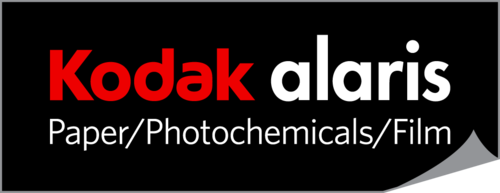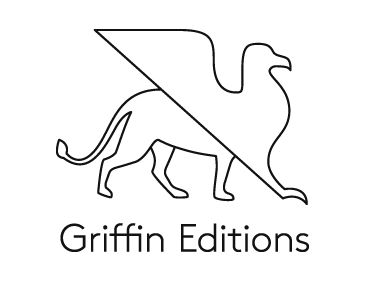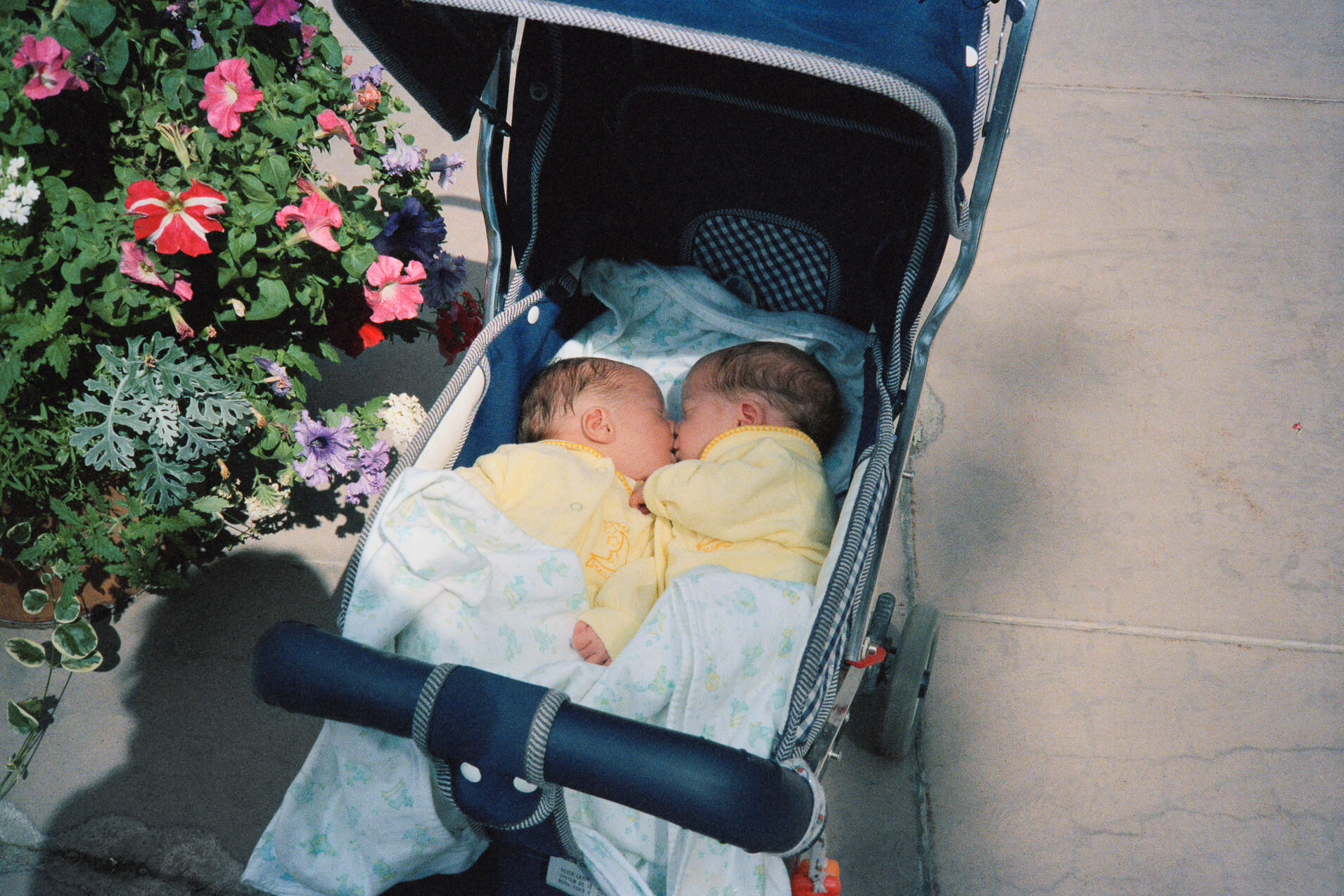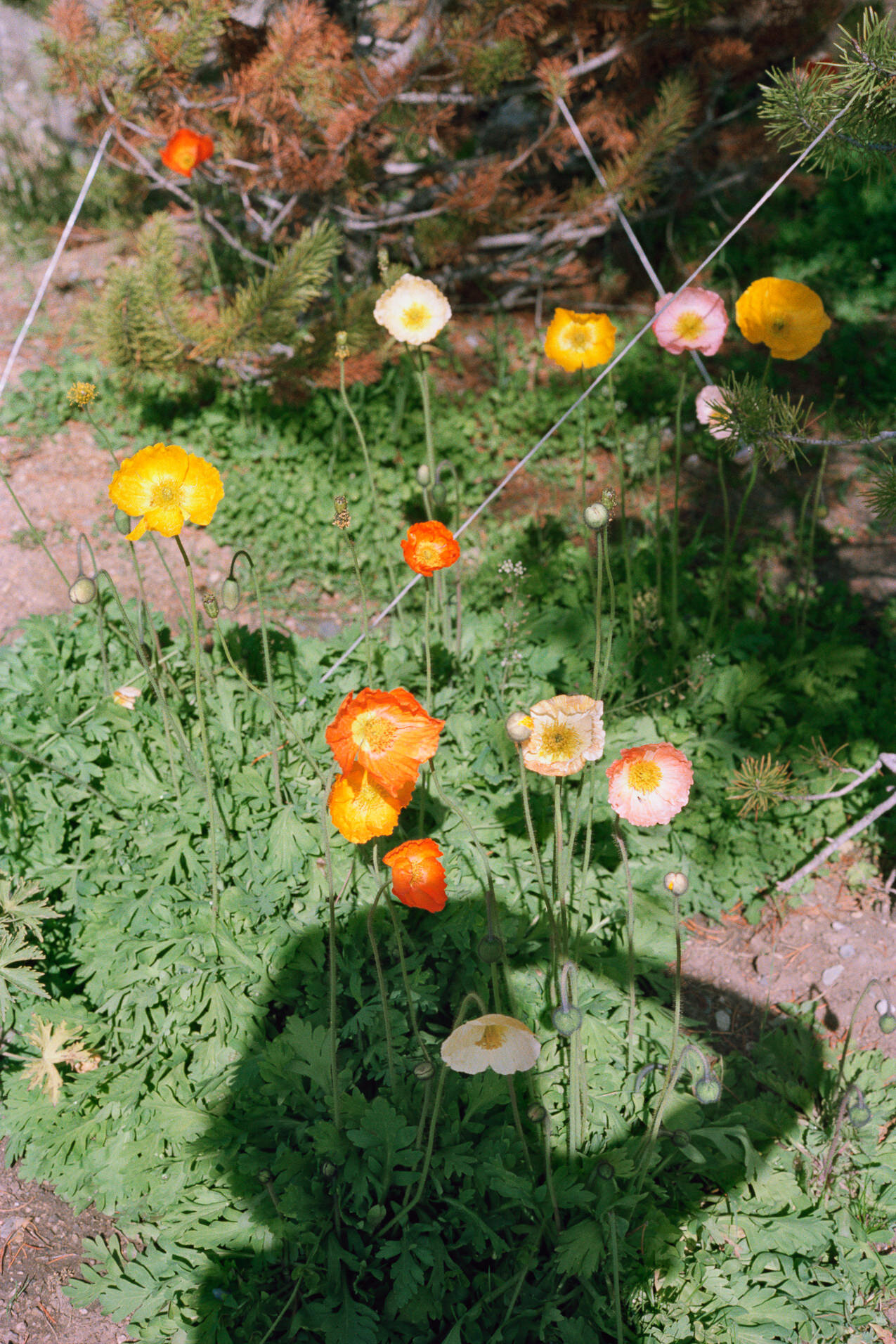Interview: Trent Davis Bailey
Trent Davis Bailey received the Film Photo Award in the Spring of 2019. One year later, Linda Moses checks back in with Trent.
What has it meant to receive this award, and to make this work with Kodak Professional Film?
Self-portrait with Kodak Film, Spring 2019
© Trent Davis Bailey
Receiving this award has been a boon of resources alleviating me of some of the financial aspects of working with large format film and in turn, encouraging experimentation. With this specific project, Kodak film carries added meaning. In particular, I have been culling images from both my family’s archive and the Flight 232 archive at The Sioux City Journal.
Not surprisingly, both archives are full of Kodak negatives. Some of these archival images have remained unseen since the film was exposed 30 plus years ago while others have been ingrained in my psyche for decades. I’m also embracing my mom’s experimentation as an artist who employed different substrates and processes in her printmaking practice; only I’m conversing with her work and legacy by using different photographic approaches and materials. My assumption is that Kodak has played a role in nearly every family archive from this past century. In Son Pictures, I am intentionally using Kodak films of different emulsions and formats to build upon and respond to my family’s varied archive of negatives, prints, films, and artifacts.
This project and many of my childhood memories would simply not be as tangible without Kodak film.
Linda Moses (LM): Hi Trent! How is life at the moment? How are the first few weeks of parenthood?
Trent Davis Bailey (TDB): Hi Linda! Life has become more of a precarious balancing act with a newborn and my perception of time has become more precious. This first month with our son has been quite lucid for me, too, which is likely because of sleeplessness and my elation that my son is here and healthy. I feel as though I have been somewhere between sleeping and waking and that has got my mind operating in something of a dream state.
Untitled (Kiss), Colorado, 1985 / © Trent Davis Bailey
Untitled (Francie's Self-portrait), Colorado, 1982 / © Trent Davis Bailey
LM: That’s really wonderful. I can only imagine the kind of awareness that brings you to in experiencing the world, a kind of novel way of seeing and understanding your surroundings. I'm sure it also brings up feelings about your own childhood.
TDB: It sure does. With parenthood comes lots of introspection and unpacking of the past.
LM: Can you tell me a bit about life growing up with your brothers and dad?
TDB: Sure. I should start by putting into context that my mom died in a commercial airplane accident when I was not quite four years old. For the decade that followed, my brothers and I grew up in an all-male household in the suburbs of Denver. My dad used to jokingly refer to our one-story ranch home as a frat house. All laughs aside, I would say that is an accurate description of our house full of boys subsisting on microwave TV dinners, Dominoes Pizza, and Kraft Mac and Cheese. One of our family rituals was that every summer after the plane crash my dad would drive my brothers and me from Denver to visit our family on the East Coast. Instead of flying, these road trips were how we went on family vacation. With my brothers and me strapped into the backseat of our family’s Suburban and my dad as captain, he referred to it as his "2,000 mile cure.”
LM: The story of the plane crash is heart wrenching, and I want to express my sympathy in any words I can. Words often fail us. But wow — the 2,000 mile cure. What a beautiful, haunting description — these trips must have really inspired your artistry. I know that people grapple with loss in a variety of ways and I think about the process as a somewhat emotionally unpredictable one. When did you decide that you wanted to make a photographic project about your experience?
TDB: Thank you, Linda. Yes, seeing America from a backseat window was so influential. You are right about this process being emotionally unpredictable, too. Last summer I thought I would retrace my dad’s road trip from Denver to the Adirondacks in upstate New York — and go on my own solitary "2,000 mile cure" — and I did, but I felt utterly uninspired and the highway just tired me out. Only once I arrived in Lake Placid [in the Adirondacks] did I find that this singular location is what I needed in that moment — the lake, the streams, and the Adirondack forest were my cure.
I have wanted to make work about this part of my family’s story for at least a decade, but I held back for many reasons. For one, I didn't want to make a project that's simply a "survivor story.” Secondly, I don’t think I had the emotional stability and preparedness to take this on when I was younger. Lastly, now that I am starting a family with my wife Emma and redefining family for myself, this work seems more approachable and meaningful.
This project is sort of a transition from my last project, The North Fork, which was in part both a response to a rift between my father and an uncle and my mom's premature death. Now, with Son Pictures I'm looking head on at my mom’s legacy: her life, her interests in art and gardening, family snapshots of her and by her, and the archive of prints and drawings she left behind. The narrative and media frenzy surrounding the plane crash also play a part in this work, especially in how I have psychically compartmentalized her death.
Untitled (Storm Cell), Iowa, 2016 / © Trent Davis Bailey
Untitled (Tarmac), Iowa, 2016 / © Trent Davis Bailey
Untitled (Overpass), Iowa, 2016 / © Trent Davis Bailey
LM: It makes sense that you needed time and space to begin this work. When we are ready, I tend to think of photography as a great medium for exploring the difficult parts of life, the feelings that are tricky to explain and intangible aspects of relationships with the people we love. Can you describe the feeling of photographing in Lake Placid, where your mother is buried?
TDB: Photographing last July in Lake Placid was unique because in that particular moment in time my mom had died exactly 30 years prior. I was also in a state of impending parenthood. My wife, who was four months pregnant, came to visit for part of my time there as did my twin brother, both of whose presences heightened my sense of familial connection. The town of Lake Placid is sort of a time capsule, somewhat stuck in the era in which it hosted the 1980 World Olympics. Instead of the town itself, I found myself much more drawn to the region’s natural splendor, much of which is accessible through the Adirondack trail system and has been remarkably preserved. Being in the forest, meandering along brooks and rivers, and floating on the lake offered me a deep sense of belonging and healing. There happened to be a full moon that week, too. The whole experience with my camera in that place felt natural and ritualistic.
LM: That sounds powerful, and the stillness and magic of your landscape images definitely express a sense of healing. Looking at your picture of the splash, compared with, say, the image of your wife holding the red fruit, I wonder how you think about the relationship between photography and slowness. It makes me think about the process of memory, which can sometimes feel slow and other times feel fleeting. Do you feel an urgency to make this work?
TDB: I felt an urgency to be in Lake Placid on the 30th anniversary of the crash, but not an urgency while I was making photographs there. In fact, it was the opposite: I would say time slowed down while I was in the Adirondacks. On the other hand, I did feel an urgency to photograph my wife throughout the pregnancy and I feel an urgency now to photograph my son who is transforming every day.
It's interesting you should mention those two pictures which are so structurally and formally different, particularly because I view both of them as portraits. The splash was created by my twin brother jumping into Lake Placid. For me, that picture is so much about gravity. My brothers were both on the plane with my mom and both of them were fortunate to survive the crash along with 182 other passengers. The fact that my twin brother, Spencer, could be with me there on that warm, luminous summer day jumping into the lake — there was joy and celebration in that. Not to get too esoteric, but this picture is more than a splash: it was created by my brother's physical body, it is proof of his existence, and it is a picture of him falling from the sky exactly 30 years after that fateful day Flight 232 fell to earth.
Untitled (Placid), New York, 2019 / © Trent Davis Bailey
Untitled (Spencer), New York, 2019 / © Trent Davis Bailey
Untitled (Ferns), New York, 2019 / © Trent Davis Bailey
LM: I admire the way that your images are layered with meanings. I feel the love that you hold for both your brother and wife, and I appreciate the various formal ways you are able to express these sentiments.
TDB: Thanks, Linda. In thinking about birth and death, it’s my hope that many of these pictures suggest that which supports life. I want to challenge how thematic elements like air, sky, and water can fit into this idiosyncratic family archive I'm making. For instance, how can I convey the importance of breath in our family story? You know, breathing, trauma, and the human body are so interconnected and I see them as key elements to this story.
LM: It’s interesting that you mention the importance of breath, which is such a visual theme in both your landscapes and portraits - especially in relation to the recurring symbols of water, reflection, and fog. I’m particularly drawn to the black-and-white picture of Emma against the tree. Do you tend to approach photographing people the same way you photograph the land?
TDB: Interesting question. I suppose it depends on how you define land. Do you include trees, bodies of water, and other living things that together create a particular ecosystem? I do feel there are parallels between the characteristics of a landscape and humans without having to anthropomorphize land or other living things. I recently read Richard Powers' book, The Overstory, which so eloquently makes trees storytellers without anthropomorphism. It just places us humans rightfully as small beings in a world much greater than ourselves where trees take center stage. I've always been attracted to that notion. When approaching a portrait or approaching land with a camera, you are always negotiating that space between yourself and this curious thing that is distinctly outside of yourself. There is a matter of scale that can differ between photographing a person and photographing land, but breadth and intimacy are possible photographing either.
Untitled (Moonset), New York, 2019 / © Trent Davis Bailey
Untitled (Mirror), New York, 2019 / © Trent Davis Bailey
LM: That’s a great point. Land is also living. I guess I tend to think of the land in terms of the sublime - the much greater world, as you said. It's a humbling perspective. I’m looking at the pictures you took on your return to Sioux City in July of 2016, which contrast the softer tone of the other images. How has your experience of the site changed with each visit?
TDB: Yes, those pictures were made on my first trip back to Sioux City as an adult. It was a reconnaissance trip when I had the smallest seed of a concept for the Son Pictures project. I was just curious what I would find if I went back there and so I planned a three-day trip and I drove to the "Heartland" from Denver in mid-July. I didn't look at the forecast and I ended up driving through the eye of this monumental Midwest storm that seemed to mirror my fears and dark emotions at that time. It was a gift to photograph something that so perfectly articulated the way I was feeling while also echoing this dark event in my memory. I then arrived in Sioux City, still so unsure about what I was getting myself into, and checked into my hotel. The receptionist gave me a room key for Room 232, which bizarrely also happened to be the number of the flight my mom and brothers had been on. [United Airlines Flight 232 crash landed at Sioux Gateway Airport in Sioux City, Iowa, on July 19, 1989.] The whole experience was uncanny — like an omen.
LM: Wow. That’s incredibly wild.
Untitled (Riverbank), New York, 2019 / © Trent Davis Bailey
Untitled (Brookside), New York, 2019 / © Trent Davis Bailey
TDB: I had anticipated going back to Sioux City last summer, too, but I decided to postpone that trip until this year. I can't explain why I didn't go back last year other than it didn't feel right. I rely a lot on my intuition with this work. I am planning on going back this year so we’ll see what that trip brings…
LM: I often find that intuition is the best guide, especially when making emotionally intense work. The process of "making work" doesn't always mean taking photographs. And it sounds like you are taking this project at the pace you need to.
I can’t help but think about the role of images in the re-telling of the story of Flight 232; both as a way to remember what happened and also, in your case, I imagine, to construct an image of your mother and of your brothers in an event you weren’t physically present for.
TDB: Yes, this project has required a lot of breathing room. It has happened in fits and starts, only when I feel like I'm emotionally available to enter into some of the darker corners of the story. What has softened things for me is that as I've collected all these materials related to my mom and our family story, I’ve felt my understanding of her and my own sense of self grow. I am coming to better understand who she was, what she cherished, and how she endured. I started this project thinking that it was about the crash, and now I'm realizing the crash is a chapter of this work, just as it was a chapter in my mom's story. It's just that — her story — that I'm connecting to as her son and seeing where we overlap and where I can make new discoveries.
Untitled (Emma with Pitaya), Hawaii, 2019 / © Trent Davis Bailey
LM: You mentioned earlier that your mother was also an artist and gardener. How has looking at her work and archive influenced your own approach to this project, and photography in general? I’m so drawn to the image she took of you and your twin brother, seemingly exchanging breaths. It’s a beautiful point of comparison to the work you are making.
TDB: I agree. There is catharsis and resolve in looking at how she saw the world through her art and through her candid snapshots. Much of her black-and-white drawings and lithographs depicted the streams and plants of the Adirondacks, while her screen prints were radically different. Her screen prints were derived from photographs and are overlapping, multi-layered color bursts evoking 1970’s psychedelia — perhaps showing more of her rebellious side. Seeing her work, you get a sense of an artist exploring the possibilities of her chosen media and her affection for the natural world while also embracing the mistakes and accidents of printmaking. I had an epiphany before my trip last year that my mom's work was an offering to me giving me permission to break out of my own existing aesthetic constraints and to experiment more. Thinking about my mental anguish surrounding my mom’s death, I’ve come to learn that so much of bereavement is wrapped up in fear. We tend to build walls around our fears surrounding grief and loss. This project is instead allowing me to break down those walls and stare curiously.
LM: That’s an inspiring way to view your relationship to your mother — as an invitation to grow and discover through loss. I see your willingness to experiment especially in the picture of the ferns and the image of Emma in labor. There’s a kind of visual uneasiness that I get from them. And the picture of Emma is so raw; you really capture a sense of empathy for her experience. What has she taught you about motherhood?
TDB: Wow, great question. Emma has changed my consciousness both within myself and with how I interact with the world around me. Her sense of self and the strength of our relationship has helped me unpack some limiting beliefs around gender binaries that were omnipresent in my all-male childhood environment. My dad tried his damnedest as a single parent, but growing up I had no daily role model in the form of a true maternal influence. In the chaos of our motherless house, I developed baseless, if damaging, ideas around the role of the mother and of the spouse. In terms of motherhood, it is a fact that females are biologically programmed and have unique hormones to handle specific roles with childbirth, but what Emma has helped me see is the power within myself to connect with notions of the Divine Feminine and overcome my own limiting beliefs. I hope that as a parent I can have both a fathering and mothering influence on my son by demonstrating my love for him and by teaching him that his birth gender does not limit or determine his experience of the world in any way.
Untitled (Emma in labor), Colorado, 2019 / © Trent Davis Bailey
LM: It sounds like you have the open-mindedness to be a wonderful parent. I guess that makes the title for this project even more apt, as a collaborative work and in setting an example of living for your child: Son Pictures. How do you envision the project evolving over the next year or so? Do you have an idea of the way you want archival materials to function with the other images you have made?
TDB: It was certainly a convenient coincidence that Emma and I should have a son while working on this project. Our son Bennett will likely become a subject in this work, and he is one of my intended audiences. I also like to imagine myself presenting this work to my mom — as a sort of conversation between our visual worlds. I am less mobile for the next few months because of my current parental duties, but I don't view that as a limitation. I imagine that I will be photographing from home more and that I will be looking more into the family archive, experimenting with and re-photographing some of the objects, and seeing where that leads me. I would like the archival materials to be seen poetically with a psychological weight, too.
LM: The way you have described this work has set it up as the continuation of a way of living, and I really admire that. It is ongoing, in a way…
TDB: Exactly, that's the tricky part with a project like this: when does it end? It’s been a relief to finally realize that trauma and grief never really leave me. I have just learned from them and devised my own ways to manage. Over the past three years, I have started to try different modalities such as meditation and therapy, and thankfully I have had art, too, which has been just another method for my coping. I have found it important to check in with old stuff, but it is also important to make sure it doesn't manifest as fatigue. Reliving trauma, and going to the source of it, has helped me process some of my mental and physical blockages, but not all of them.
So far, this project has allowed me to recognize the crucial relationship between breathing and trauma. Part of what has attracted me to work with a large format field camera is that it encourages a deepening of focus, a slowness, and a turning inward as I look outward. Looking at the ground glass, I have realized that breathing deeply and seeing deeply are concomitant. What I mean by that is that breathing deeply encourages clarity and enhanced bodily perception, and in turn, that aids how I see the world and experience the phenomena unfolding around me.
LM: It seems that this work has been full of coincidences, and maybe that’s life. But I think that you’re taking the right approach — to leave the door open and confront what you find along the way. I'm excited to see where it leads you! And thankful to have had this conversation with you. It’s been wonderful and illuminating.
TDB: Thanks, Linda! It has been a pleasure.
Untitled (Emma at five months), Hawaii, 2019 / © Trent Davis Bailey









